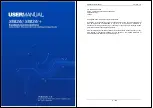
File Buffering
73
7.4 RAM Disk Organization
The space available on the RAM disk is 32 MB. Approximately 2 MB is used by the operating
system, and the remainder is available for storage. You may create and remove subdirectories,
and copy, move, rename and delete files.
The directories listed below are automatically created by the system:
1.
A subdirectory is created for each host port that has buffering enabled. The data collected
from the host port is stored in this subdirectory. The subdirectory is given the same name as
the host port by default. To view the host port directory, type OPBUFh# (Where h# is the
desired host port number) at the system prompt. You will see a response similar to: ’--- Open
Host Buffer File --- 01/05/96 22:22:36 [AUX] Buffer \HOST1\CURRENT.0 Opened O.K.’ Type
DIR at the system prompt and the response will be similar to:
Site123>DIR
--- List Directory ---
Current Directory: \HOST1
CURRENT.0 0 10/05/98 22:22
Total Bytes on Drive: 30578688 Free: 30486528
Site123>
Screen 7-2. List Directory Screen
2.
The \SENTFILES is a directory in which is stored a copy of each file sent to the
administration PC. These files can be deleted automatically after a preset number of days or
when space available on RAMdisk reaches a critical level.
3.
The \LOGFILES is a directory, which contains files that are generated each day by the ASG
Guard/ASG Guard Plus, to maintain a record of that day’s activities. These files are of two
types: Event files, which list the alarms that were processed during one day, and Log files,
which contain a copy of one day’s log history.
7.4.1 Host Port Buffer Naming
The user may change the default directory name for each host port. For example, if Host port 1 is
being used to monitor a Meridian switch, then directory name may be changed to Meridian. See
Section 7.6.1 for more information on changing the directory name.
7.4.2 Buffer File Naming Conventions
Filenames consist of capital letters and numbers and can have a maximum of 12 characters. A
period followed by a three-character extension may be used provided the total number of
characters does not exceed 12.
Examples:
101296AM.100
REPORT.01
IMPORTANTLOG
Note that in the screen above the default filename is CURRENT.0. The current buffer file for a
host port is always named either CURRENT.0 or CURRENT.1. When the buffer is switched, the
buffer file is renamed to indicate the host port number from which the data was collected and the
date and time the buffer was opened.
Summary of Contents for Lucent Technologies Access Security Gateway Guard
Page 12: ...x Page intentionally left blank ...
Page 28: ...ASG Guard Overview 16 Page intentionally left blank ...
Page 36: ...Physical Connections 24 Page intentionally left blank ...
Page 60: ...Modem Port Setup 48 Page intentionally left blank ...
Page 82: ...Modifying the User Database 70 Page intentionally left blank ...
Page 120: ...Action and Event Tables 108 Page intentionally left blank ...
Page 158: ...User Connectivity 146 Page intentionally left blank ...
Page 188: ...Log Functions 176 Page intentionally left blank ...
Page 236: ...Troubleshooting 224 Page intentionally left blank ...
Page 252: ...Internal Battery Replacement 240 Page intentionally left blank ...
Page 258: ...Glossary of Command References 246 Page intentionally left blank ...
















































